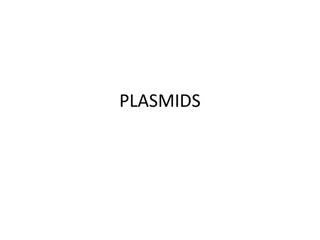REGULATION OF PLASMID COPY NUMBER
Plasmids regulate their copy number to maintain a balance that doesn't burden the host cell. Copy numbers vary based on factors like plasmid size and culture conditions. Plasmids are classified as stringent or relaxed based on replication control. Various systems, including counter-transcribed RNAs
4 views • 17 slides
Understanding Plasmid Partitioning Mechanisms in Bacteria
The stable maintenance of low-copy-number plasmids in bacteria relies on partition mechanisms that ensure proper positioning during cell division. Different from high-copy-number plasmids, which rely on random diffusion, low-copy-number plasmids require regulated partitioning mechanisms to prevent d
0 views • 14 slides
Understanding Transgenic Plants and Agrobacterium Tumefaciens in Plant Biotechnology
Creation of transgenic plants involves various methods such as microprojectile DNA-coating, electroporation, and Agrobacterium transformation. Agrobacterium tumefaciens, a soil bacterium, plays a crucial role in inducing crown gall disease in plants by transferring T-DNA from the Ti plasmid. The Ti
1 views • 27 slides
Understanding Plasmids: DNA Molecules Free of Chromosome
Plasmids are DNA molecules existing free of the chromosome in a cell. They can be circular or linear and carry genes beneficial to the host. Plasmids replicate from unique origins and regulate copy numbers through various mechanisms. Different replication mechanisms, such as theta and RC, are used,
0 views • 31 slides
Basic Biology of Plasmid and Phage Vectors
Plasmids are replicons inherited extrachromosomally, existing as circular DNA molecules. They can be categorized as conjugative or non-conjugative based on transfer genes presence, and by copy number per cell. Linear plasmids and their maintenance mechanisms are also discussed, along with phenotypic
0 views • 13 slides
Understanding Recombinant DNA Technology and Plasmid Vectors
Explore the world of recombinant DNA technology through the utilization of plasmids as vectors for gene cloning. Learn about techniques like insertional inactivation and the characteristics of common plasmid vectors such as pBR322. Discover the intricacies of genetic manipulation in bacterial origin
0 views • 26 slides
Understanding Crown Gall Disease in Plants
Crown gall is a plant tumor induced by the soil bacterium A. tumefaciens, resulting in oncogenic transformation. Opine metabolism plays a central role in the disease, with Ti-plasmids carrying T-DNA responsible for unregulated growth and opine synthesis. Border sequences on the Ti-plasmid are crucia
0 views • 17 slides
Understanding CIDAR MoClo Labs in Synthetic Biology Teaching
In CIDAR MoClo Labs, students learn DNA engineering concepts, construction of plasmids, and analysis of fluorescent data. Background knowledge of DNA, proteins, bacterial plasmids, and the LacZ method is required. Skills include pipetting, DNA measurement, bacterial transformation, and plate reader
0 views • 19 slides
Bacterial Conjugation: Mechanism and Applications
Bacterial conjugation is the process of transferring genetic material between bacterial cells through direct contact or bridge-like connections. Discovered in 1946, this mechanism enables the transfer of DNA regions between various bacterial species, including Gram-negative and Gram-positive bacteri
0 views • 58 slides
Understanding Cloning in Yeasts: Vectors and Selectable Markers
Yeasts like Saccharomyces cerevisiae and Schizosaccharomyces pombe are valuable organisms for eukaryotic gene expression. They offer easy growth like bacteria and are genetically well-characterized. Yeast selectable markers and vectors enable efficient cloning and expression of genes. The use of shu
0 views • 16 slides









